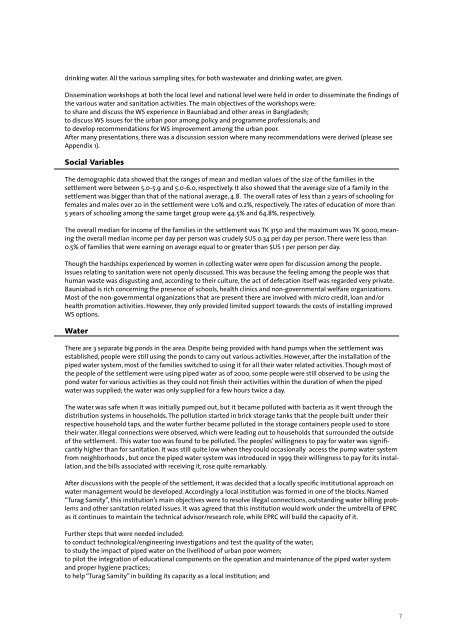Untitled - UNU-IAS - United Nations University
Untitled - UNU-IAS - United Nations University
Untitled - UNU-IAS - United Nations University
You also want an ePaper? Increase the reach of your titles
YUMPU automatically turns print PDFs into web optimized ePapers that Google loves.
drinking water. All the various sampling sites, for both wastewater and drinking water, are given.<br />
Dissemination workshops at both the local level and national level were held in order to disseminate the findings of<br />
the various water and sanitation activities. The main objectives of the workshops were:<br />
to share and discuss the WS experience in Bauniabad and other areas in Bangladesh;<br />
to discuss WS issues for the urban poor among policy and programme professionals; and<br />
to develop recommendations for WS improvement among the urban poor.<br />
After many presentations, there was a discussion session where many recommendations were derived (please see<br />
Appendix 1).<br />
Social Variables<br />
The demographic data showed that the ranges of mean and median values of the size of the families in the<br />
settlement were between 5.0-5.9 and 5.0-6.0, respectively. It also showed that the average size of a family in the<br />
settlement was bigger than that of the national average, 4.8. The overall rates of less than 2 years of schooling for<br />
females and males over 20 in the settlement were 1.0% and 0.2%, respectively. The rates of education of more than<br />
5 years of schooling among the same target group were 44.5% and 64.8%, respectively.<br />
The overall median for income of the families in the settlement was TK 3150 and the maximum was TK 9000, meaning<br />
the overall median income per day per person was crudely $US 0.34 per day per person. There were less than<br />
0.5% of families that were earning on average equal to or greater than $US 1 per person per day.<br />
Though the hardships experienced by women in collecting water were open for discussion among the people.<br />
Issues relating to sanitation were not openly discussed. This was because the feeling among the people was that<br />
human waste was disgusting and, according to their culture, the act of defecation itself was regarded very private.<br />
Bauniabad is rich concerning the presence of schools, health clinics and non-governmental welfare organizations.<br />
Most of the non-governmental organizations that are present there are involved with micro credit, loan and/or<br />
health promotion activities. However, they only provided limited support towards the costs of installing improved<br />
WS options.<br />
Water<br />
There are 3 separate big ponds in the area. Despite being provided with hand pumps when the settlement was<br />
established, people were still using the ponds to carry out various activities. However, after the installation of the<br />
piped water system, most of the families switched to using it for all their water related activities. Though most of<br />
the people of the settlement were using piped water as of 2000, some people were still observed to be using the<br />
pond water for various activities as they could not finish their activities within the duration of when the piped<br />
water was supplied; the water was only supplied for a few hours twice a day.<br />
The water was safe when it was initially pumped out, but it became polluted with bacteria as it went through the<br />
distribution systems in households. The pollution started in brick storage tanks that the people built under their<br />
respective household taps, and the water further became polluted in the storage containers people used to store<br />
their water. Illegal connections were observed, which were leading out to households that surrounded the outside<br />
of the settlement. This water too was found to be polluted. The peoples’ willingness to pay for water was significantly<br />
higher than for sanitation. It was still quite low when they could occasionally access the pump water system<br />
from neighborhoods , but once the piped water system was introduced in 1999 their willingness to pay for its installation,<br />
and the bills associated with receiving it, rose quite remarkably.<br />
After discussions with the people of the settlement, it was decided that a locally specific institutional approach on<br />
water management would be developed. Accordingly a local institution was formed in one of the blocks. Named<br />
“Turag Samity”, this institution’s main objectives were to resolve illegal connections, outstanding water billing problems<br />
and other sanitation related issues. It was agreed that this institution would work under the umbrella of EPRC<br />
as it continues to maintain the technical advisor/research role, while EPRC will build the capacity of it.<br />
Further steps that were needed included:<br />
to conduct technological/engineering investigations and test the quality of the water;<br />
to study the impact of piped water on the livelihood of urban poor women;<br />
to pilot the integration of educational components on the operation and maintenance of the piped water system<br />
and proper hygiene practices;<br />
to help “Turag Samity” in building its capacity as a local institution; and<br />
7
















